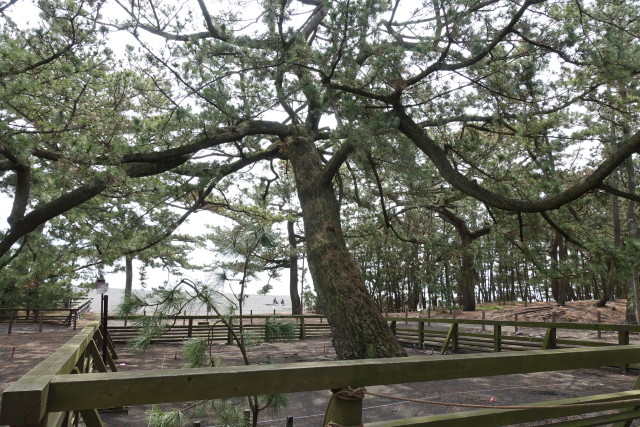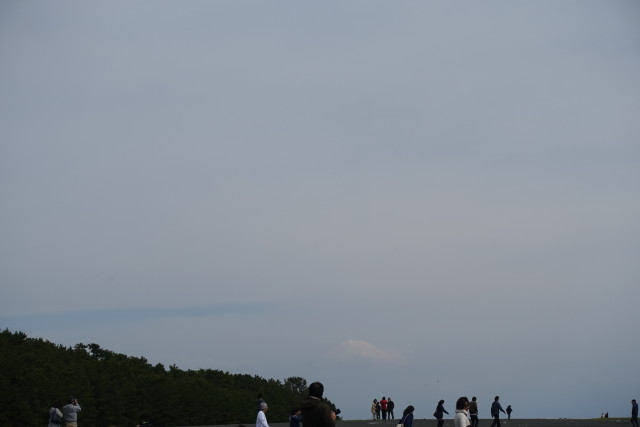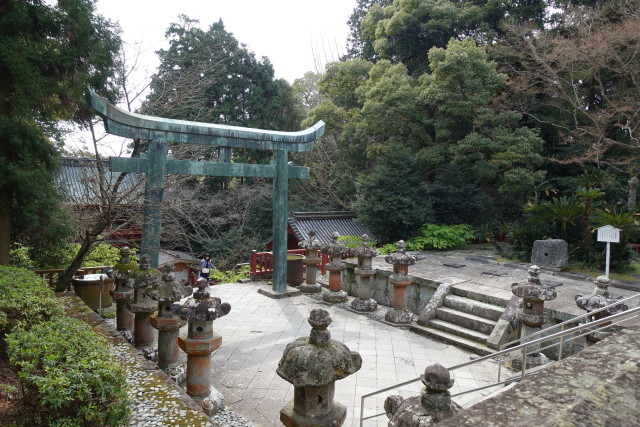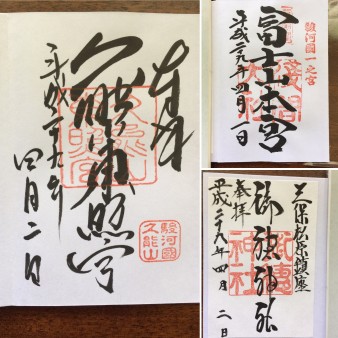On April Second, we visited “Miho no Matsubara (Miho Pine Grove)” which is famous for “Hagoromo Densetsu (The Swan maiden)” and “Kunozan Toshogu” noted in connection with Tokugawa Ieyasu.
From JR Shimizu Station to “Miho no Matsubara” it took about 25 minutes by bus and another 10 minutes on foot. The following pictures are a restaurant on the way to the “Miho no Matsubara.” An old man with a red face sat in front of the entrance door.
We reached the “Miho no Matsubara.” This place is one of Japan’s three major Matsubara (pine grove) and there are about 30,000 pine trees along the shoreline having a length of 7 km. The pines are at ages ranging from 200 to 400 years, and others havea ages of more than 500 years old. This area is also added to the World Heritage List.
This road, which is called “Kami no Michi (Road of God)”, has a full length of about 500 m up to the seashore.
Finally, we reached the seashore. When you go up the stairs, you can see the sea.
The pine trees bend over or tilt, maybe because of the strong wind, but the trees still spread their branches.
This tree is the “Pine Tree of Hagoromo,” on which a heavenly nymph put her hagoromo (robe), famous for the “Hagoromo Densetsu (the Swan maiden).”
This is the shoreline. A wide beach spreads out here, Suruga Bay is adjacent to the beach, and Izu Peninsula can be seen in the distance. This beach is spacious and really comfortable.

The shrine on the beach is called “Haguruma Shrine.”
A view of Mt. Fuji from the beach!
At the entrance of the “Kami no Michi,” there is the “Miho Shrine” which is related to the “Hagoromo Densetsu.” The road through the Torii (shrine front gate) is the “Kami no Michi.”
Some structures of the “Miho Shrine.”
Then, we went to “Shimizu Port” and had lunch in a restaurant in the fish market.
After lunch, we went to “Kunozan Toshogu” via a ropeway from “Nihondaira.”
This is the view from the ropeway car departing “Nihondaira Station”.
Cherry blossoms at the bottom of a valley seen from a window of the ropeway car.
This is “Kunozan Station.”
This is “Kunozan Toshogu.” There was a Romon (tower gate or two-story gate) near the ropeway station. The stairs had a high step height, in order to prevent easy invasion by enemies.
Statues of “A-Un” in the right and left corners in the Romon.
The wood plate says “Shinba (sacred horse).”
“Koro (Drum Tower).”
The building on the right side is “Kagura Hall (a hall for Shinto music and dance).”
“Sukibei” (see-through fences) surrounding “Haiden” and “Honden.”
This is the “Haiden” (Worship Hall or Outer Shrine).
Engravings inside the “Karamon.”
The “Honden (Main Hall or Inner shrine)” can be seen behind the “Sukibei.”
Sculpted engravings on the bottom area of the “Sukibei.”

The west wall of the “Honden.”
The roofs of the “Honden” (on this side) and the “Haiden” (just behind). The buildings of the “Toshogu” are all gorgeously painted with brilliant colors of red, green and gold. I think that the technique is splendid.
There is a tomb of Tokugawa Ieyasu beyond the stone stairs.
This is the tomb of Ieyasu. Ieyasu was buried in this tomb according to his will, and his bones were moved to “Nikko Toshogu” when it was completed.

During our Shizuoka trip this time, the weather was not good, but the places that we visited were all nice. We were also glad that the seafood was very tasty and cheap. The following Chinese calligraphy plates known as “Go-Shuin” are those we got during this trip.













































Leave a Reply